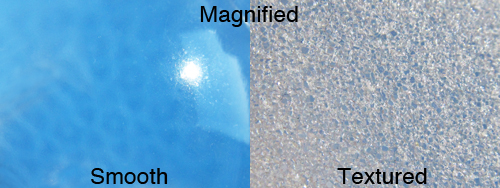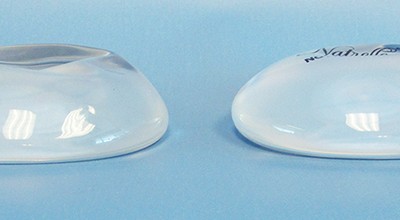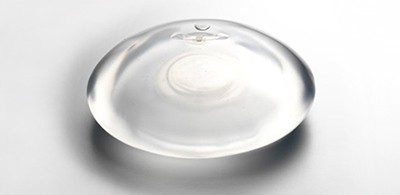
Breast Implant Surface Texture
Smooth Implant Surface vs. Textured Implant Surface
The surface of breast implants can be smooth or textured. The shell of a smooth implant is relatively transparent and slippery. The shell of a textured implant feels somewhat like the soft looped side of Velcro; though the texturing has a much different shape and composition. Each manufacturer uses different methods for texturing their implants, so the textured surfaces look and feel different. The height and depth of the surface texturing ranges from about 150 μm (Mentor Siltex) to 200-350 μm (Allergan BioCell).
The very first breast implant (c.1963) was made with a smooth surfaced shell. These implants were placed in the subglandular space, above the muscle. Placement of the implant in the subglandular space resulted in capsular contracture for some individuals, however. Even as breast implant designs were subsequently modified, the subglandular space was the preferred location for a breast implant for many years.
Textured implants were introduced to the market in the mid-1980s, in an attempt to reduce the risk of capsular contracture seen with subglandular implant placement. Since the fibrous capsule forms immediately adjacent to the implant shell, a textured shell was designed to cause a more irregular capsule surface. When compared to the capsule present around a smooth surface implant, the capsule around a textured surface implant contained collagen bundles which were more disorganized. The disorganized collagen was felt to contract less, thereby reducing the risk of capsular contracture.
When the textured implant surface works as it is intended, the implant actually becomes adherent to the capsule; the capsule forms through the surface texturing, securing the implant. When this occurs, the risk for capsular contracture may be less. Studies have shown that textured implants placed under the breast gland (above the muscle) have a lower rate of capsular contracture when compared to smooth implants under the breast gland. Unfortunately the textured surface does not always adhere to the capsule; and when it doesn’t, the implant is then functionally no different than a smooth surfaced implant. It is important to note that there has not been a study which definitely demonstrates that textured surface implants result in lower rates of capsular contracture.
Textured implant surfaces also serve one other function. They create friction between the implant and the pocket, and thus reduce implant mobility. As a result, anatomically shaped implants (Natrelle 410 and Mentor CPG) are now made with only textured surfaces to prevent rotation and malposition.
The vast majority of saline and silicone implants used today are smooth-surfaced round implants. These work well in the subpectoral position where the risk of capsular contracture is felt to be lower.
NEXT TOPIC: Breast Implant Profile
What is the Gel-to-Shell Fill Volume Ratio?
Each round silicone gel-filled breast implant is comprised of a silicone elastomer shell which contains the silicone gel filling. Silicone gel breast implants are filled by the manufacturer with a moderately cohesive (responsive) silicone gel. If you look carefully at...
How Firm is a Saline Breast Implant?
During the consultation today, a patient asked me, "Aren't saline implants harder?" Well, it actually depends. Let me start by saying that if you have ever held a saline implant and a silicone gel implant side-by-side, you know that they feel completely different, and...
Do I need to change my breast implants after 10 years?
During breast augmentation consultations women frequently make a comment, or ask a question, about having to change their breast implants every 10 years. The comment or question is usually worded in such a way that they have the understanding that breast implants need...
An Example of Poor Breast Implant Selection: Case Study
Thoughtful breast implant selection is the key to a natural, long-lasting result. The following case illustrates one of the potential problems associated with poor implant selection - when the implant diameter exceeds the pocket dimensions. History Lesa, a 36-year-old...



